Why you can trust Tom's Hardware
Benchmark Results and Final Analysis
Our standard benchmarks and power tests are performed using the CPU’s stock frequencies (including stock boosts), with all power-saving features enabled. Optimized defaults are set in the BIOS and the memory set using the XMP profiles. For this baseline testing, Windows is set to High Performance before switching over to Balanced during power testing, so the PC idles appropriately.
Synthetic Benchmarks
Synthetics are a great tool to determine if a board runs out of spec, as identical settings should produce similar performance results. Advanced memory timings are the one place where motherboard makers can still optimize for either stability or performance, though, and those settings can impact some testing.





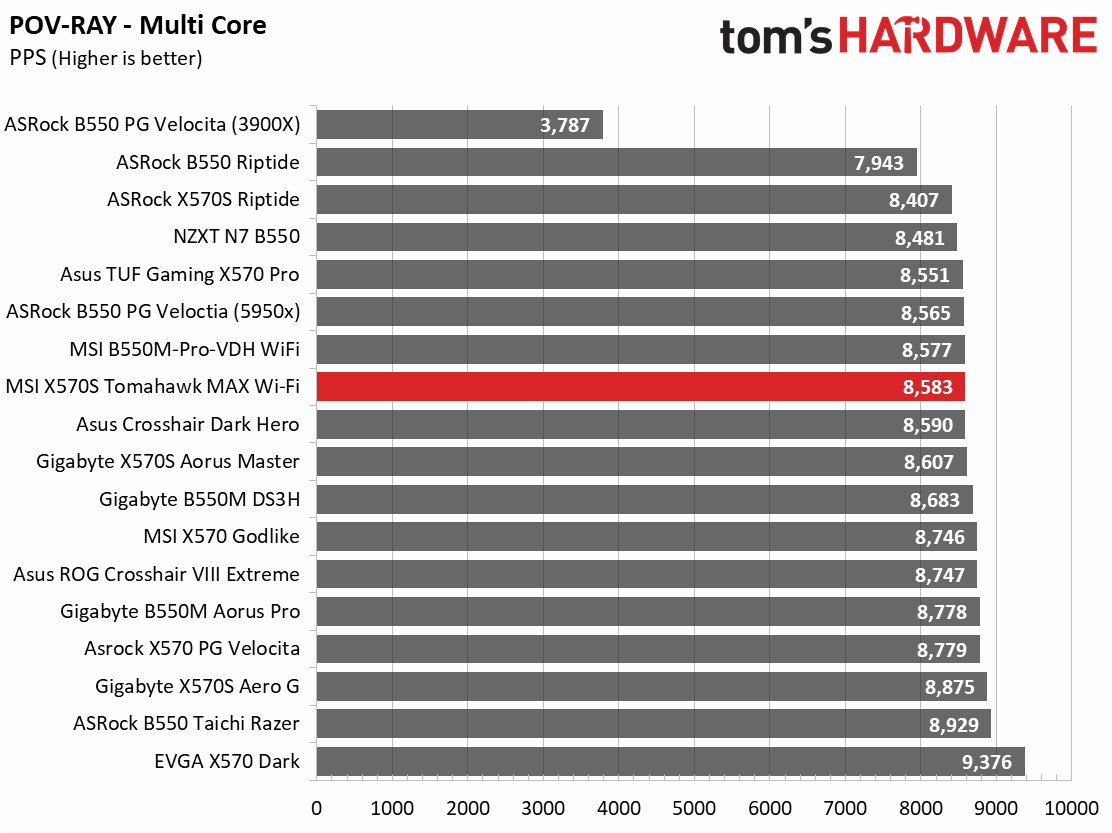



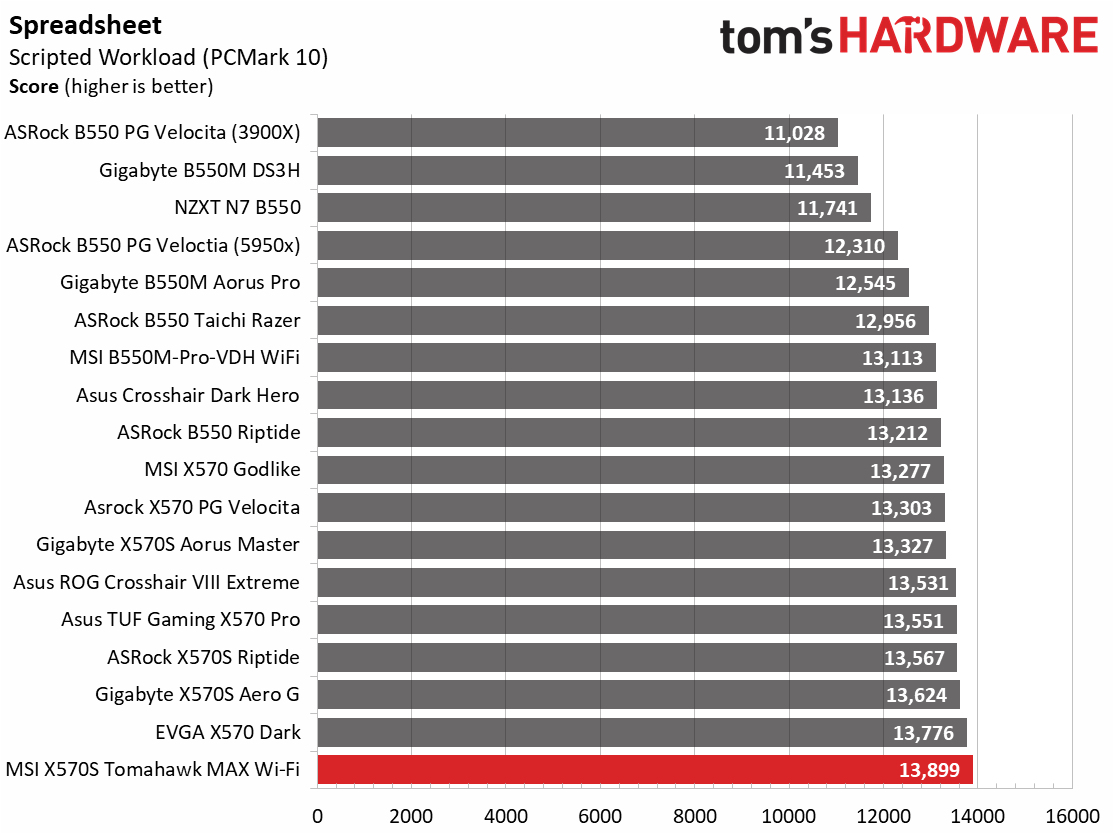
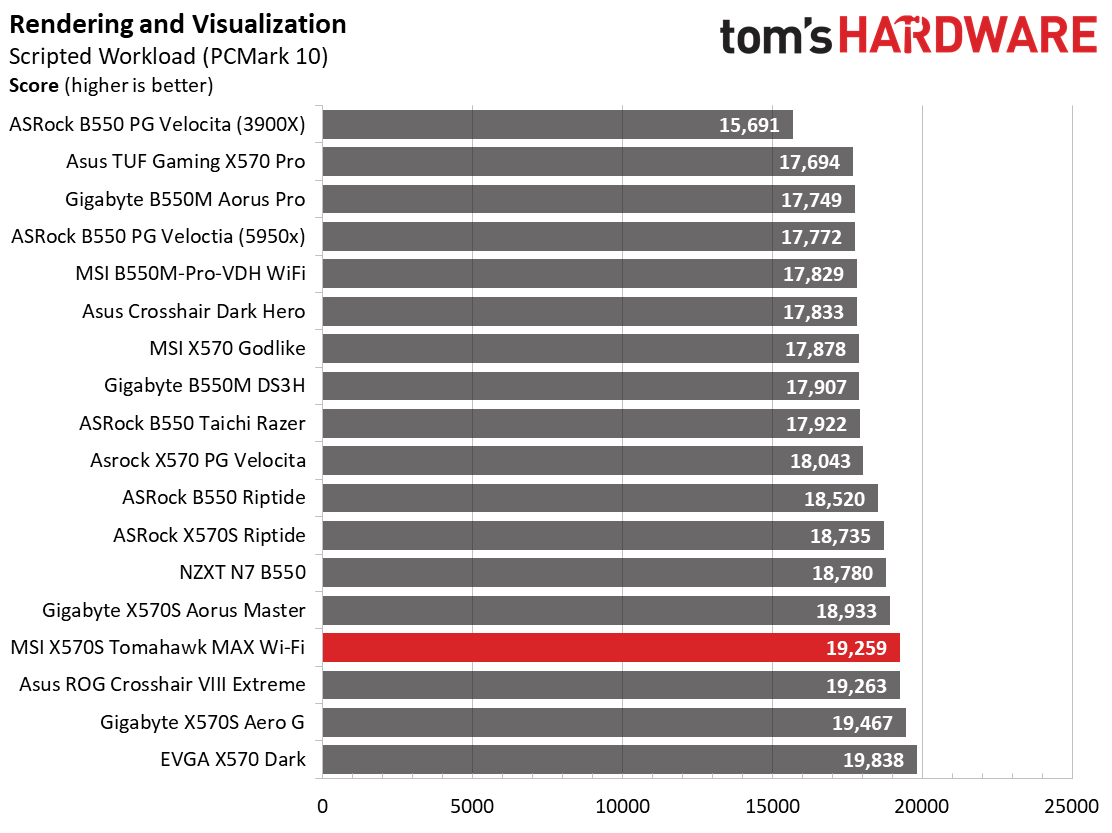





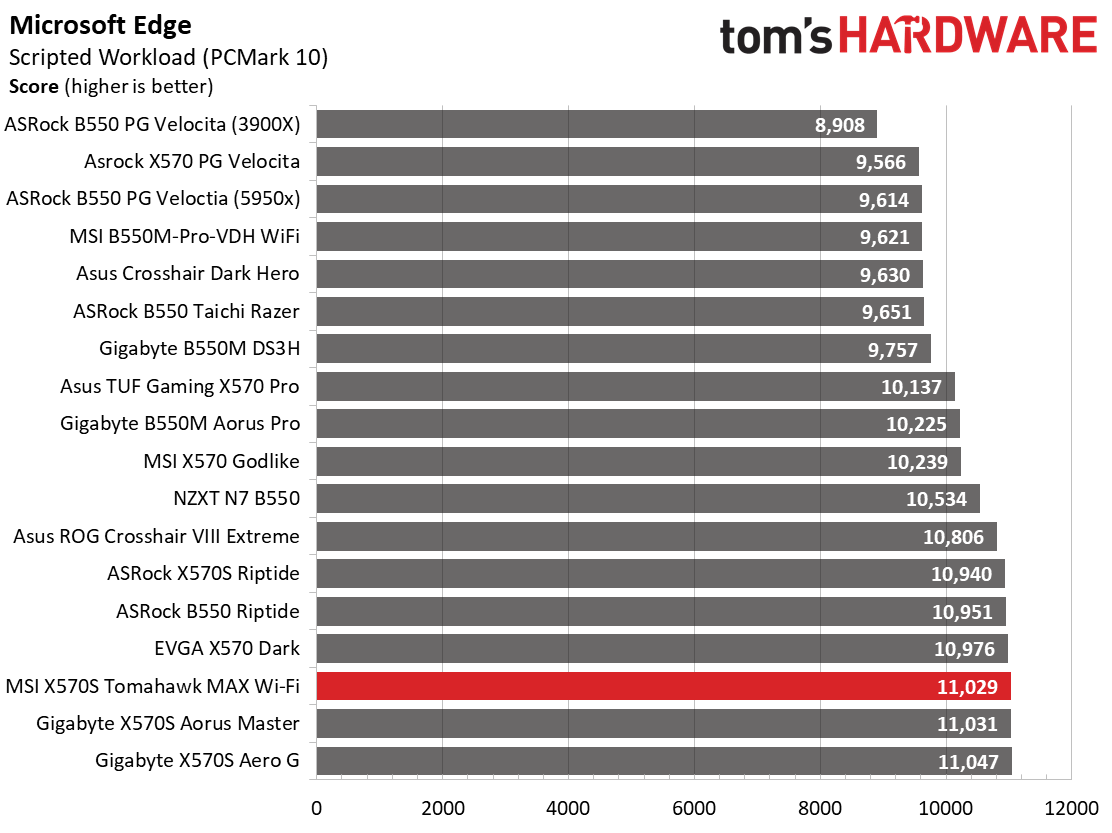




In our synthetic benchmarks, the X570S Tomahawk MAX performed around average, to slightly below average, in all tests not named PCMark 10. POV-Ray and Cinebench were the slowest of the group, running just short of average. 7Zip was a tale of two tests, where it was just above the median in compression and just below in decompression. That said, none of these results were far off those from other tested boards. PCMark 10 tests were outstanding, as most results were better than other tested boards. In fact, in some tests, the Tomahawk scored the highest of all tested boards so far. AIDA memory results were average as far as transfer rates. However, the latency was the highest we’ve seen so far, and is partly why some scores are lower.
Timed Applications


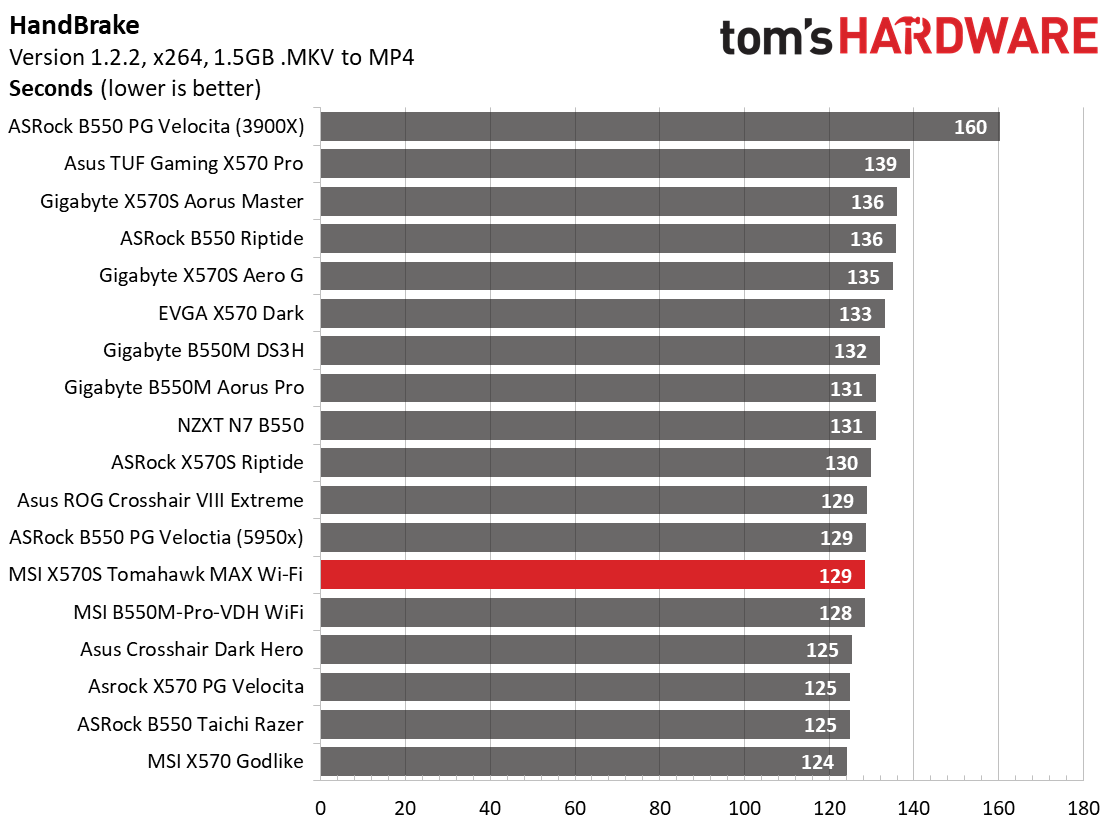

In our LAME testing, the X570S Tomahawk MAX delivered one of the fastest results, posting a time of 11.73 seconds (average is 11.93 with this dataset), the second quickest result. Corona testing resulted in a time of 47 seconds, which is 1 second slower than average (around a 1.5% difference). Lastly, in our Handbrake testing, the x264 results were close to the average (a bit faster than) at 129 seconds. The x265 test ran in 305 seconds, within the run variance of average (306 seconds, or well less than 1%). None of the results here stuck out as being too different than the rest.
3D Games and 3DMark




Starting with the launch of the X570S chipset, we’ve updated our game tests and hardware (video card) to match the Intel platform. We stopped using The Division 2 and Forza Horizon 4 and now use Far Cry: New Dawn and F1 2020, running on the Asus TUF Gaming RTX 3070. The games are run at 1920x1080 resolution using the Ultra preset. As the resolution goes up, the CPU tends to have less of an impact. The goal with these settings is to determine if there are differences in performance at the most commonly used resolution with settings most people use or at least strive for. So far, the difference between boards in these tests is slight, with most falling within margin of error differences.
In F1 2020, the X570S Tomahawk averaged 209 Frames Per Second, the slowest result so far. That said, it’s a mere 2 FPS (about 1%) behind the average -- hardly noticeable. This board averaged 134 FPS in Far Cry, which is a 2 FPS (just above 1%) above average. As far as the 3DMark tests go, the Firestrike score of 16,657 was right on average, while the 13,561 score in Time Spy is the fastest result so far, although again, these are all extremely close together.
Power Consumption / VRM Temperatures
We used AIDA64’s System Stability Test with Stress CPU, FPU and Cache enabled for power testing, using the peak power consumption value. The wattage reading is from the wall via a Kill-A-Watt meter to capture the entire ecosystem. The only variable that changes is the motherboard; all other parts are the same.
Get Tom's Hardware's best news and in-depth reviews, straight to your inbox.
At idle, the X570S Tomahawk MAX used 70W, which is slightly better than average (around 76W for these data points). Load wattage peaked at 204W, about 15W (several percent) better than the average of boards in the chart. We saw the CPU fluctuate between 3.7 and 4.2 GHz during testing, which is typical behavior. This averages out to 137W and ends up as one of the more efficient boards we’ve tested thus far.




During temperature testing, our X570S Tomahawk MAX peaked just under 44 degrees Celsius during stock operation, which is one of the cooler results we’ve seen on a board with passive heatsinks. When overclocked to 4.4 GHz, VRM temperatures peaked around 56 degrees Celsius, again one of the cooler temperatures we’ve recorded so far. The heatsinks do a bang-up job keeping things cool, even with the CPU pushed to its ambiently cooled limits.
Overclocking
There are several ways to overclock on AMD platforms, depending on your goals. If your focus is single-threaded performance, you may want to focus on using Precision Boost Overdrive (PBO) and adjusting its parameters. If you can use all cores and threads, setting a manual CPU multiplier and voltage is likely the better route. While the latter clips peak single-threaded performance slightly, it increases all core/thread performance over the all-core boost. To that end, we settled on 4.4 GHz at ~1.3V for an all-core/thread overclock.
The Tomahawk MAX had no issues with our 16-core/32-thread Ryzen 9 5950X. We simply plugged in ~1.3V, adjusted LLC to all but eliminate vdroop, and trudged through the test.
On the memory side, we know AMD is limited to around 3600/3733 MHz when keeping the FCLK at a 1:1 ratio with the memory. With this in mind, we add two more sticks and run 4x8GB at DDR4 3600, which is AMD’s current sweet spot. We were able to set XMP for our review board, and it was stable enough to run through several of our benchmarks. As always, your mileage may vary depending on the memory kit used and the quality of the CPU’s integrated memory controller as to what speeds you can reach.
Final Thoughts
MSI’s MAG Tomahawk boards have been a staple in the budget/mid-range motherboard market for a couple of generations now. The previous board was known for its pricing and well-rounded feature set and brought a military-style appearance. Fast forward to today and the latest Tomahawk in our hands does the same. In addition to the chipset fan deletion, which makes the board silent, it updates Wi-Fi 6 to 6E and updates to the latest audio codec from Realtek. There are some aesthetic changes as well, but they look similar overall, retaining that military theme. In the end, the board is more of an iterative update than some other X570S boards that took the opportunity to update power delivery and appearance more along with other hardware. But for those who would like a budget/mid-range X570 option with the latest generation audio and Wi-Fi, the $289.99 X570S Tomahawk MAX has you covered.
Our Tomahawk MAX WIFI performed well overall and overclocked our Ryzen 9 5950X without issue. Itlooks the part of an inexpensive motherboard, as the heatsinks and shrouds only cover the required components, but certainly doesn’t make you turn away. I would like to have seen MSI update the appearance more, but it’s a decent-looking board that doesn’t draw attention to itself and blends in with most build themes.performance or overclocking side of things either.
As far as comparable options, there aren’t many X570S boards at this price point. ASRock’s X570S Riptide is an actual budget entry at under $200, but Gigabyte has a true competitor in the X570S Aorus Elite WIFI. Asus doesn’t have anything in the price bracket (the Crosshair VIII Hero is $409.99) that’s available, though there are rumors we’ll see some of the Gaming SKUs get a refresh. It feels like although a lot of these X570S boards were announced several weeks ago, they’re still vaporware at the time of this writing. If you look at existing X570 boards, you’ll find plenty out there, but you’ll lose the updated hardware, power delivery, and updates to the appearance that most X570S boards include.
MORE: Best Motherboards
MORE: How To Choose A Motherboard
MORE: All Motherboard Content

Joe Shields is a staff writer at Tom’s Hardware. He reviews motherboards and PC components.
-
eklipz330 does anyone x570 chipset fan EVER turn on? i have mine on the silent profile and it almost never turns on. i leave hwinfo running and even with a 3080, my chipset fan never even hits the threshold to turn on. I've heard you could even change the TIM on it and it would bring the temperatures down even lower.Reply -
Geezer760 These are your words in first paragraph: "and makes a compelling option to build your budget/mid-range AMD Ryzen-based system around." - Since when is a $290.00 MB considered "Budget" or "Mid-range", imo $290.00 is still too expensive even for mid-range. "JUST BUY IT" right?Reply -
jpe1701 ReplyGeezer760 said:These are your words in first paragraph: "and makes a compelling option to build your budget/mid-range AMD Ryzen-based system around." - Since when is a $290.00 MB considered "Budget" or "Mid-range", imo $290.00 is still too expensive even for mid-range. "JUST BUY IT" right?
Toms Hardware isn't the only ones trying to sugar coat the dramatic increase in the cost of motherboards over the last few years. -
Alvar "Miles" Udell I would say this MSI board is great, but it's priced about $30 too high where the main buyers are people who will be going long on Socket AM4 and will be wanting forward looking features like more than 2 M.2 slots.Reply
I would say the Gigabyte X570S Aero G is a better choice. Yes it's $60 which isn't chump change, it's a 20% price increase, but you get 2 more M.2 ports and a host of additional USB ports, including the USB 3.2 Gen 2x2 port lacking on this board, and really the only tradeoff is WiFi 6 vs 6E.
Gigabyte X570S Aero G Review: A Silent, Updated Vision | Tom's Hardware (tomshardware.com) -
JoBalz Replyeklipz330 said:does anyone x570 chipset fan EVER turn on? i have mine on the silent profile and it almost never turns on. i leave hwinfo running and even with a 3080, my chipset fan never even hits the threshold to turn on. I've heard you could even change the TIM on it and it would bring the temperatures down even lower.
I had been wondering if something was wrong with my fan, as it hardly ever turns on either. Nice to know MSI appears to have determined the fan wasn't required and skipped it on the updated board. I've been very satisfied with my MAG X570 Tomahawk WIFI, especially as I got it on sale for at the time. -
Neilbob You need a 'Subjective' column in which to put things like basic styling, RGB and all that jazz.Reply -
Co BIY $290 - Where is my AMD motherboard discount ?Reply
Is there an article that explains the changes with X570S in general ? -
Alvar "Miles" Udell ReplyCo BIY said:$290 - Where is my AMD motherboard discount ?
Is there an article that explains the changes with X570S in general ?
Basically it's just what the 400 series chipset was to the 300 series, only very minor tweaks but essentially the same. AIBs have taken the opportunity to better equip X570S boards with features compared to X570, generally, but as far as the chipset itself goes the only real difference is the lack of fan.

